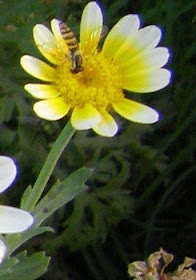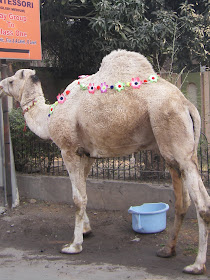Sohan Halwa or Sohan Halva is a traditional northern Indian and Pakistani sweet.
It is made by boiling a mixture of water, sugar, milk and cornflour until it becomes solid. Saffron is used for flavoring. Ghee is used to prevent it from sticking to the pan. Almonds, pistachios and cardamom seeds are added. Unlike most other halwa dishes in the subcontinent, it is solid.
Here's the recipe:
Ingredients:
2 cups Corn Flour
Almonds
Pistachios
Cardamom Seeds
1 tsp. Saffron
3 cups Sugar
1 cup Whole Milk
2 cups Clarified Butter (Ghee)
Flat Tray (greased)
Method:
Heat 3 cups of water in a heavy based pot. Add in sugar and boil for 10 minutes. Add 1 cup of milk and boil for another 5 minutes and strain.
Dissolve the cornflour in 1 cup of water. Add this to the previous mixture. Dissolve saffron in a little bit of water, and add to the cornflour mixture. Cook over low heat. When the cornflour mixture starts becoming thick, start adding in the oil a little by little. Continue adding the oil slowly to prevent it from sticking to the bottom of the pan. Continuously stir while it is cooking.
When the mixture starts separating and begins lump formation, add the almonds, pistachois and cardamom seeds and mix.
Have your pre-greased tray ready, and spread the sohan halwa mixture on it. Flatten mixture by pressing.
Garnish with almonds and pistacchios. Let it cool then cut into square pieces and serve.
Sunday, April 25, 2010
Saturday, April 24, 2010
Tonga, Horse-drawn Carriage
Confined to the back streets of Lahore, the tongas are increasingly the vehicles of the poor for whom motor-powered transportation is a luxury.
Monday, April 19, 2010
Longan
Closely allied to the lychee, the longan has been referred to as the 'little brother of the lychee'. Longan is slightly smaller than lychee, and with a dull brown skin which is smoother than that of the lychee. The fruit taste is similar, and the value of longan on the market is due to the fact that its season follows that of the lychee, extending the period when this type of fruit is available. According to the esteemed scholar, Prof. G. Weidman Groff, the longan is less important to the Chinese as an edible fruit, more widely used than the lychee in Oriental medicine.
The fruit grows in drooping clusters. Fruit is globose, 1/2 to 1 inch in diameter, with thin, brittle, yellow-brown to light reddish-brown rind. The flesh is whitish, translucent, somewhat musky, sweet, but not as sweet as that of the lychee and with less "bouquet". The seed is round, jet-black, shining, with a circular white spot at the base, giving it the aspect of an eye.
Health Benefits of Longan
- Longan is used as remedy for stomach ache, insomnia, amnesia, and dropsy.
- The fruit is said to invigorate the heart and spleen, nourish the blood and have a calming effect on the nervous system.
- A spoonful of longan tonic made of equal quantities of longan flesh and sugar simmered in water till it is reduced to a syrup consistency is recommended twice a day.
- A decoction of the dried flesh is taken as a tonic and treatment for insomnia and neurasthenic neurosis.
- In Vietnam, the "eye" of the longan seed is pressed against snakebite in the belief that it will absorb the venom.
- The seeds are administered to counteract heavy sweating, the pulverized kernel, which contains saponin, tannin and fat, serves as a styptic (substance that draws together or constricts body tissues and is effective in stopping the flow of blood or other secretions). (Source)
Saturday, April 17, 2010
"Reyri" ( Donkey & Cart)
Donkey is an animal which has been opressed by humans since ages. Today, in third world countries, donkey still has the same fate, busy in work at all times.The Donkey carts are a major part of bazaars and roads in Pakistan .
Monday, April 12, 2010
Saturday, April 10, 2010
"Murder"
A group of crows is called a "murder", though this term usually appears in poetry or similar literature rather than ordinary usage.Happy CC Day everyone!
Thursday, April 8, 2010
Hot...Hot...Summer
As temperatures continue to rise, the number of people coming to hospitals and clinics has increased due to the rapidly increasing temperatures. The situation is compounded by hours of power outage.The main victims of the hot weather and load shedding are mostly children and the elderly who are contracting various diseases due to the extreme weather and lack of sleep at night. On the other hand, students are not able to prepare for their exams and doctors are unable to carry out operations and surgeries due to constant power cuts. Domestic as well industrial and commercial life has been brought to a standstill, the whole situation is aggravated by the non-availability of water.This is unfair...we have 16 hours of loadshedding today, while in Army Housing Areas, they don't suffer at all.My mother-in-law has left for Rawalpindi because she can't stand the heat , at least there...no power outage in my brother-in-law's residence...Hmmmm.....This is just one of the situation where I can say..IF YOU ARE IN THE ARMY....you have too much benefits and privileges especially if you are an officer.
Monday, April 5, 2010
The Angels Montessori
Sunday, April 4, 2010
Saturday, April 3, 2010
The Camel
Camels have lived in some of the most desolate corners of our planet, and not only do they live, they thrive. Most large animals are unable to survive in these kinds of desolate places. This is because of their large requirement for resources such as food and water. Camels are able to use this to their advantage as a survival strategy. By living in deserts, mountains, and other arid places Camels are able to avoid predators, and others who would compete for resources. Camels are only able to do this because of their amazing ability to efficiently use the resources their environments provide. A camel can travel long distances which allow them to take advantage of the maximum number of resources. They can withstand a massive amount of dehydration which allow them to survive not only between watering holes, but sometimes between seasons. When at a watering hole camels are able to gorge themselves and rehydrate quickly. For food, camels are omnivorous. They can eat almost anything be it vegetation, meat, or bone,-- salty or sweet, a camels stomach knows no limits. But it is their temperament that is truly endeared the camel to man. Docile and sweet under a caring hand, but stubborn and angry if ill treated, the camel both wins your heart and your
respect.(Copied from:http://fohn.net/ )
respect.(Copied from:http://fohn.net/ )
My entry for Camera Critters second anniversary and Ruby Tuesday.
Friday, April 2, 2010
Happy Birthday Timami!
To all my blogger friends, help me make Timami's birthday memorable.Please visit her site and greet her.She's the youngest blogger, I've met, an Indonesian staying in Islamabad.
Thursday, April 1, 2010
April Fools Day
Today is April Fools Day so be on your toes and mentally alert for unforeseen pranks, practical jokes and
other forms of mischief. According to Wikipedia, April Fools' Day or All Fools' Day is a day celebrated in various countries on April 1. The day is marked by the commission of hoaxes and other practical jokes of varying sophistication on friends, family members, enemies, and neighbors, or sending them on a fool's errand, the aim of which is to embarrass the gullible. Traditionally, in some countries, such as the UK, Australia, and South Africa the jokes only last until noon, and someone who plays a trick after noon is called an "April Fool". Elsewhere, such as in France, Ireland, Italy, South Korea, Japan, Russia, The Netherlands, Brazil, Canada, and the U.S., the jokes last all day. The earliest recorded association between April 1 and
foolishness can be found in Chaucer's Canterbury Tales (1392).
other forms of mischief. According to Wikipedia, April Fools' Day or All Fools' Day is a day celebrated in various countries on April 1. The day is marked by the commission of hoaxes and other practical jokes of varying sophistication on friends, family members, enemies, and neighbors, or sending them on a fool's errand, the aim of which is to embarrass the gullible. Traditionally, in some countries, such as the UK, Australia, and South Africa the jokes only last until noon, and someone who plays a trick after noon is called an "April Fool". Elsewhere, such as in France, Ireland, Italy, South Korea, Japan, Russia, The Netherlands, Brazil, Canada, and the U.S., the jokes last all day. The earliest recorded association between April 1 and
foolishness can be found in Chaucer's Canterbury Tales (1392).
Just like other festivals that Pakistanis have adopted from the West like Valentines Day and New Year’s Night, the tradition of April Fool is also popular among the youngsters.
















